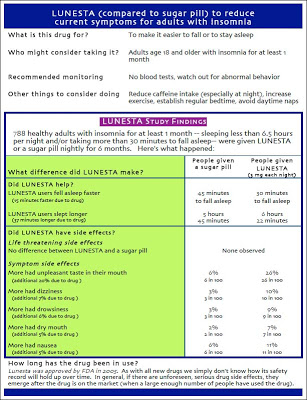Good morning, Pharma Marketing Blog fans! It’s Friday and that means it’s time for the Bob (Ehrlich) vs John (Mack) Friday Morning Smackdown! Every Friday, Ehrlich, who publishes the DTC Perspectives Magazine and Blog, sends me his opinion on a DTC (direct-to-consumer) advertising topic and I try to “smack down” his ideas. That’s a bit of an exaggeration. What we have here is an attempt at communication in a point-counterpoint fashion. Hopefully, we all learn more and are entertained as well.
Today, Bob wrote about a Dartmouth Study that concludes a “Fact Box” on risk/benefit is good for consumers. Presumably, Fact Boxes would be included in all print DTC ads, on product web sites, and with the drug when it is picked up at the pharmacy.
The study included a mock up of a Fact Box for Lunesta (shown below; click on it for an enlarged view), a popular sleep aid drug that has been heavily advertised to consumers.

Bob cited a New York Times story about the study that coincidentally quoted him (see “A Push to Spell Out a Drug’s Risks and Benefits“). You can read about the study here.
The Fact Box proposed by the Dartmouth researchers includes only data from the FDA-approved package insert (PI), which is based solely on the clinical trial data submitted to the FDA as part of the approval process.
Bob says he supports “anything that gives consumers… numerical information.” But he suggests other “facts” should be added. “Drug companies and FDA should also include all relevant information in a fact box,” said Ehrlich, “including post marketing data, even if that is less perfect than controlled clinical studies.”
I assume “less perfect” means nonfactual because facts are facts — they are by definition perfect! Regardless of perfection, whenever you hear the word “marketing” as in “post-marketing data,” you should be wary about the “facts” that are gleaned from the data. Bob admits it would take a “lot of work from the objective medical community” to include such post-marketing data in Fact Boxes.
While physicians can obtain such additional data through medical journals, consumers rarely have access to vetted post-marketing data about drugs. So, it makes sense that consumers should also have access to such data as long as it is accurate — as perfect as possible.
Yet the “objectivity” of the medical community has come into question recently. Therefore I’m not sure what Bob proposes would work and it may just open up another door inviting DTC critics to enter and piss in the DTC tent.
BTW, there are some “facts” in the Lunesta Fact Box that I don’t quite understand. The authors commented on these facts in a video (here). From their comments, I conclude that the authors are a tad biased against DTC advertising to begin with. For example, the Fact Box cited “facts” on drowsiness and indicated that “More had drowsiness (additional 6% due to drug).” I assume “More” means “More patients on the drug.”
But why is drowsiness a side effect? Isn’t drowsiness a benefit of a sleep aid drug? It turns out that this really refers to drowsiness after awakening the next day, “which is ironic” said one of the authors of the study, “because the whole the purpose of the drug is to treat your insomnia, let you sleep well, and feel rested the next day.” Coincidentally, the new Lunesta ads emphasize how rested you feel when waking up the next day (see “New Lunesta Print Ad: 70% LESS Moth!“).
The point is that this “fact” as presented in the Fact Box is not clear, IMHO. This is a case where more “data” is not always a good thing, especially when it’s not clear how to interpret the data.
Another “fact” that appears in the Lunesta Fact Box is in the section “How long has the drug been in use?” Only one fact is presented there: “Lunesta was approved by the FDA in 2005.” The rest is opinion on how you should interpret this fact: “As with all new drugs we simply don’t know how its safety record will hold up over time. In general, if there are unforeseen, serious drug side effects, they emerge after the drug is on the market (when a large enough number of people have used the drug).”
According to the NY Times, “Dr. Woloshin and Dr. Lisa Schwartz, also of the Dartmouth institute, plan to present their case to the F.D.A. during a meeting of the agency’s advisory committee on ‘risk communication.’ That panel is examining how best to provide consumers with data about prescription drugs using printed matter like package inserts.” Find more information on this meeting here. NOTE: If you plan to attend, you’ll have to leave your shoes outside (see back story here and here).








![6 Digital Tools at the Center of Healthcare Digitalization [INFOGRAPHIC]](http://ec2-54-175-84-28.compute-1.amazonaws.com/pharma-mkting.com/wp-content/uploads/2021/04/6DigitalTools_600px-100x70.jpg)




